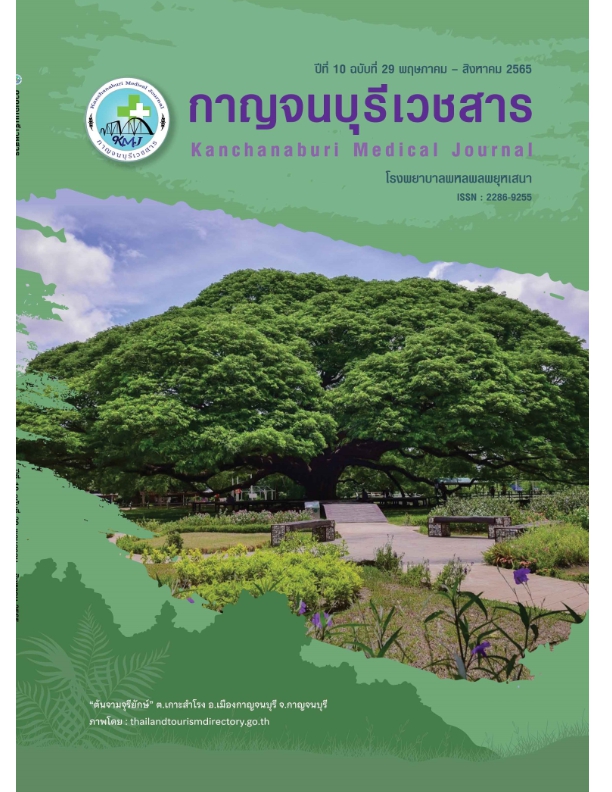Clinical presentations, bacterial profile and antibiotic susceptibility patterns of pediatric urinary tract infection in Phaholpolpayuhasena hospital
Abstract
Urinary tract infection is a common infection in children. Delayed diagnosis and inappropriate treatment may lead to renal scarring, hypertension and chronic kidney disease. Escherichia coli is the most common pathogen. Antimicrobial resistance of urinary pathogens is increasing worldwide. Knowledge of local etiologic agents and antibiotic susceptibility patterns is important for choosing appropriate treatment.
Objectives To study antibiotic susceptibility patterns, common bacterial pathogens and congenital anomalies of kidneys and the urinary tract. Methods This is a retrospective review of medical records of children with urinary tract infection, aged 1 month to 14 years old from January 2015 to December 2021 in Phaholpolpayuhasena hospital.
Results Ninety four patients were included. Fourty four patients (46.81%) were male. The median age was 1.04 (0.17, 14.33) years. The most common pathogen was Escherichia coli (89.36%), of which 26.6% were ESBL producing organisms. Results of antimicrobial susceptibility analysis for Escherichia coli to antibiotics are as follows: ampicillin 10.53%, ceftriaxone 72.62% and amikacin 100%. Ultrasound was performed in 85 cases and 20 patients (23.53%) presented hydronephrosis. VCUG was performed in 33 cases and 7 patients (21.21%) presented VUR. The ESBL producing group showed significantly higher rates of antibiotic treatment and hospitalization within the previous3 months, a longer duration of parenteral antibiotics and change of antibiotics during treatment.
References
Lashkar MO, Nahata MC. Antimicrobial Pharmacotherapy Management of Urinary Tract Infections in Pediatric Patients. The Journal of pharmacy technology: jPT: official publication of the Association of Pharmacy Technicians. 2018;34(2):62-81.
Mirsoleymani SR, Salimi M, Shareghi Brojeni M, Ranjbar M, Mehtarpoor M. Bacterial pathogens and antimicrobial resistance patterns in pediatric urinary tract infections: a four-year surveillance study (2009-2012). International journal of pediatrics. 2014;2014:126142.
Tullus K, Shaikh N. Urinary tract infections in children. Lancet (London, England). 2020;395(10237):1659-68.
Simões ESAC, Oliveira EA, Mak RH. Urinary tract infection in pediatrics: an overview. Jornal de pediatria. 2020;96 Suppl 1:65-79.
Morello W, La Scola C, Alberici I, Montini G. Acute pyelonephritis in children. Pediatric nephrology (Berlin, Germany). 2016;31(8):1253-65.
Okarska-Napierała M, Wasilewska A, Kuchar E. Urinary tract infection in children: Diagnosis, treatment, imaging - Comparison of current guidelines. Journal of pediatric urology. 2017;13(6):567-73.
Ammenti A, Alberici I, Brugnara M, Chimenz R, Guarino S, La Manna A, et al. Updated Italian recommendations for the diagnosis, treatment and follow-up of the first febrile urinary tract infection in young children. Acta paediatrica (Oslo, Norway: 1992). 2020;109(2):236-47.
Leung AKC, Wong AHC, Leung AAM, Hon KL. Urinary Tract Infection in Children. Recent Pat Inflamm Allergy Drug Discov. 2019;13(1):2-18.
Thergaonkar RW, Hari P. Current Management of Urinary Tract Infection and Vesicoureteral Reflux. Indian journal of pediatrics. 2020;87(8):625-32.
Kaufman J, Temple-Smith M, Sanci L. Urinary tract infections in children: an overview of diagnosis and management. BMJ Paediatr Open. 2019;3(1):e000487.
Schmidt B, Copp HL. Work-up of Pediatric Urinary Tract Infection. The Urologic clinics of North America. 2015;42(4):519-26.
Roberts KB, Subcommittee on Urinary Tract Infection SCoQI, Management. Urinary Tract Infection: Clinical Practice Guideline for the Diagnosis and Management of the Initial UTI in Febrile Infants and Children 2 to 24 Months. Pediatrics. 2011;128(3):595-610.
Stein R, Dogan HS, Hoebeke P, Kočvara R, Nijman RJ, Radmayr C, et al. Urinary tract infections in children: EAU/ESPU guidelines. European urology. 2015;67(3):546-58.
Buettcher M, Trueck J, Niederer-Loher A, Heininger U, Agyeman P, Asner S, et al. Swiss consensus recommendations on urinary tract infections in children. Eur J Pediatr. 2021;180(3):663-74.
Woo B, Jung Y, Kim HS. Antibiotic Sensitivity Patterns in Children with Urinary Tract Infection: Retrospective Study Over 8 Years in a Single Center. Child Kidney Dis. 2019;23(1):22-8.
Amornchaicharoensuk Y. Clinical Characteristics And Antibiotic Resistance Pattern Of Pathogens In Pediatric Urinary Tract Infection. The Southeast Asian journal of tropical medicine and public health. 2016;47(5):976-82.
Pouladfar G, Basiratnia M, Anvarinejad M, Abbasi P, Amirmoezi F, Zare S. The antibiotic susceptibility patterns of uropathogens among children with urinary tract infection in Shiraz. Medicine. 2017;96(37):e7834.
Topaloglu R, Er I, Dogan BG, Bilginer Y, Ozaltin F, Besbas N, et al. Risk factors in community-acquired urinary tract infections caused by ESBL-producing bacteria in children. Pediatric nephrology (Berlin, Germany). 2010;25(5):919-25.
Kizilca O, Siraneci R, Yilmaz A, Hatipoglu N, Ozturk E, Kiyak A, et al. Risk factors for community-acquired urinary tract infection caused by ESBL-producing bacteria in children. 2012;54(6):858-62.
Downloads
Published
How to Cite
Issue
Section
License
Copyright (c) 2022 Phaholpolpayuhasena Hospital

This work is licensed under a Creative Commons Attribution-NonCommercial-NoDerivatives 4.0 International License.
บทความที่ได้รับการตีพิมพ์เป็นลิขสิทธิ์ของโรงพยาบาลพหลพลพยุหเสนา
ข้อความที่ปรากฏในบทความแต่ละเรื่องในวารสารวิชาการเล่มนี้เป็นความคิดเห็นส่วนตัวของผู้เขียนแต่ละท่านไม่เกี่ยวข้องกับโรงพยาบาลพหลพลพยุหเสนาและบุคลากรท่านอื่น ๆ ในโรงพยาบาลฯ แต่อย่างใด ความรับผิดชอบองค์ประกอบทั้งหมดของบทความแต่ละเรื่องเป็นของผู้เขียนแต่ละท่าน หากมีความผิดพลาดใด ๆ ผู้เขียนแต่ละท่านจะรับผิดชอบบทความของตนเอง



 Phaholpolpayuhasena Hospital
Phaholpolpayuhasena Hospital
